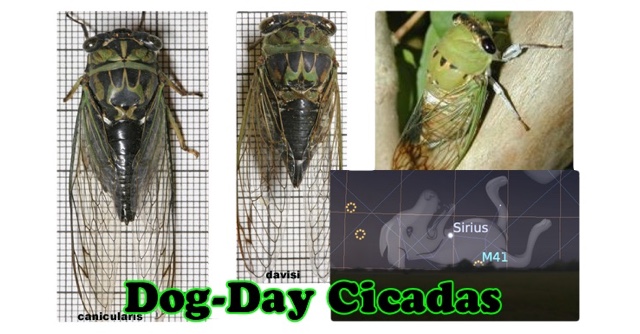

Sometime during each summer, some of the nymphs dig a relatively large hole (sometimes with a mud "chimney" 3 to 4 inches high!) through the soil surface from which they emerge to cling to the bark of trees or other objects while they molt into the adult stage. These insects resemble our typical dog day cicadas, which we see in mid-to-late summer in Wisconsin, but they are orange and black with vibrant reddish eyes instead of a dull greenish color. Cicada nymphs molt four times as they grow. When the tiny cicada nymphs hatch six or seven weeks later, they fall to the soil, burrow and spend from two up to 10 years feeding on the roots of various plants where they cause no noticeable injury. These stems may eventually die and eventually drop to the ground.

Females jab their eggs into small stems with their saw-like ovipositors. Adults may suck juices from tender twigs. The females are mute and are attracted to the males' songs. Neotibicen cicadas are large, robust, dark insects with light markings and greenish margins on the wings. We also have one species of the annual Cicada and one species of the annual petite Cicadetta. The males sing high in trees with long, loud, songs composed of buzzes and clicks. Neotibicen cicadas are often called dogday or harvestfly cicadas because the males sing from mid to late summer. These annual cicadas are part of charm of our summers.

Adults can live for 5 to 6 weeks.Description and Biology Skip to Description and BiologyĪt least 13 species of Neotibicen cicadas occur in North Carolina.
#Dog day cicada skin
Adult cicadas emerge from this last nymphal stage through a crack along the back, leaving the light brown cast skin behind. The nymphs climb onto tree trunks, low plants or other objects. Under some conditions, the exit hole is associated with a mud cone or chimney 3 to 4 inches high. Fully developed nymphs burrow out of the ground at night, leaving a 1/2-inch hole behind them. As they molt through several growth stages (instars), they may burrow several feet down. They burrow into the soil, seeking tree roots. In 6 to 7 weeks, small nymphs hatch from the eggs and drop to the ground. Female cicadas insert clusters of eggs into the twigs and small branches using a saw-like egg laying structure (ovipositor). The common dog-day cicadas (sometimes called the annual cicadas or locusts) appear in late summer and have life cycles of 2 to 5 years. Life CycleĬast skin of a cicada that has emerged as an adult. Adult cicadas do not feed on leaves, but may suck juices from tender twigs. Male cicadas rest on tree trunks and branches and “sing” to attract females, producing a periodic whine by means of two special vibrating membranes in the sides of the abdomen. Adults emerge from April through July, depending upon species and locality. The periodical cicada species that do occur in Texas complete their life cycles in 13 years, although some emerge almost every year. The smaller periodical cicada, Magicicada septendecim (Linnaeus), completes its life cycle in 17 years, and emerges in large numbers (broods) in large geographical areas. Nymphs resemble wingless adults, are brown and have strong front legs well developed for tunneling in the soil. Bailey / Lake County News-Sun) As adults, they just want to mate. The larger species are about 1-5/8 inch long and 1/2-inch wide with brown or green, black and white body markings. Dog-day or annual cicadas sing each year at the height of summer. Similar to other cicadas, the dog-day cicada have prominent bulging eyes and semi-transparent wings held roof-like over their large bodies. Most recently reviewed by: Pat Porter (2018) Common Name(s): Dog-Day Cicada Description


 0 kommentar(er)
0 kommentar(er)
